| December 15, 2002
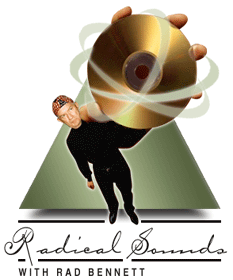 Radical Sounds:
Keeping Secrets from a Public that Wants to Know? Radical Sounds:
Keeping Secrets from a Public that Wants to Know?
About four months ago, a label promoter wrote to me to ask
if I could help her. Another reviewer had called in a panic, asking about the center
channel in a recording. Was it there on the recording? Was his system just not reproducing
it? Well, it was there and, as we found out, his system was reproducing it just fine. It
is simply that it wasn’t used all the time or, perhaps, wasn’t used for the
material one would normally expect.
Multichannel audio formats have opened up entirely new
possibilities to producers. If a producer wants to use the center channel for one note in
a 25-minute piece, he or she can. It is unlikely that this would happen, but it is
possible. Bass can be put into the center channel, which was the case in this particular
recording. Or, the center channel, or subwoofer channel in particular, can go entirely
unused. You will not find a center channel on David Chesky’s recordings.
So, how can a person know if his or her system is
functioning properly? I am reminded of the early days of stereo when reel-to-reel tape
became a format for commercial recordings. Often the two channels would be unbalanced. One
solution was to put test tones at the beginning of the tape so listeners could adjust
their systems accordingly. Multichannel producers could do that, but I think most
consumers would find the practice upsetting and distracting, just as it was on the
reel-to-reel tapes.
What producers might do, however, is to tell the consumer
in the jacket notes which channels are being used. Just saying "multichannel" is
not enough. That could cover anything above stereo. It might be 3.0, 4.0, 3.1, 4.1, 5.0,
or 5.1. Did I leave anything out? You see how many possibilities there are! Do consumers
want to know? I think so. If these are technically advanced formats, then let’s have
some technically advanced specifics in the notes. If people do not want the information,
they don’t have to read it, but if they do, they cannot if it is not there. It might
also be good to have information about the original recording and the transfer. Some
companies are good about this, but it is far from a given that you will find such
information on the release you just received in the mail or brought home from the store.
Kudos to DTS, which has tried to find a solution for use
with its DVD-Audio releases. Its new release of Sheila Nicholls’ Wake contains
a graphic on the back cover that clearly tells what the disc is about. Using the diagrams
found on many DVD-Video discs as a departure point, DTS lets us know that this disc
contains MLP 5.1 Surround tracks, DTS-ES 6.1 tracks, and PCM 2.0 tracks. Moreover, we are
given the sampling rate for each, as well as which DVD players will play which tracks. A
box on the right tells one about DVD "Bonus Features." But, wouldn’t you
know it? Just at press time, Warner sent a couple of new discs that have a similar
information box. But why, considering that there is a DVD-Audio "group,"
couldn’t the charts have been standardized so they would be the same from release to
release and company to company? I opt for the DTS version; it is easier for me to read
quickly, but others might prefer the Warner layout. Yet shouldn’t they be the same?
Yes, they should, but either, though imperfect, seems a
step in the right direction to honestly and clearly let the consumer know what to expect
before unwrapping the disc and putting it into a player. He or she deserves nothing less.

DTS info box
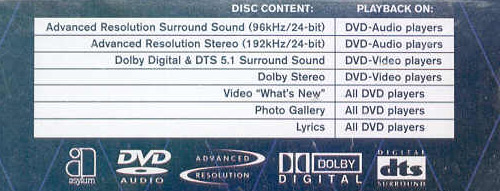
Warner Bros. info box
The Latin Jazz Trio
Luis Conte (percussion), David Garfield (piano), David Carpenter (bass).
AIX 80011, DVD-Audio/Video. Contains MLP 5.1 "audience" mix, 5.1 Dolby Digital
"stage" mix, PCM 24/96 stereo mix. 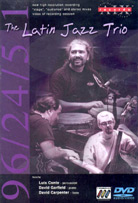 Here is another triumph from Mark Waldrep and his fledgling AIX label. For
this hybrid DVD, he has assembled three great musicians, players who obviously enjoy
working together and have a special affinity for the Latin repertory. He has deployed them
logically on a stage in a small auditorium: piano on the left, percussion on the right,
bass in the middle. Then, using his 24/96 recording wizardry, he has captured them in
sound that has just the right amount of everything: presence, clarity, and warmth. As
usual, he has provided a double-sided hybrid disc. One side is DVD-Video and contains
full-motion video, with a Dolby Digital "stage" perspective mix. For the other
side, which is MLP 24/96 DVD-Audio, he has selected an "audience" mix that puts
just a little distance between players and listener. Not too much, mind you. It seems just
right to me. The listener is not a participant in this mix, yet thanks to a very discreet
bit of ambiance in the surrounds, there is a feeling of intimacy and being in the same
space as the musicians. Most listeners will immediately note the clarity of this MLP 5.1
mix, especially in reproducing tingly percussion such as wind chimes, bells, and struck
cymbal. If you are one of those who are absolutely against any trace of surround, Waldrep
has also provided clean-as-a-whistle 24/96 stereo tracks. The video side of this hybrid
disc contains a lot of information on the recording process and the performers, as well as
a photo gallery and system setup and check information. Overall, this is an outstanding
release that sizzles, but in a gentle way. Here is another triumph from Mark Waldrep and his fledgling AIX label. For
this hybrid DVD, he has assembled three great musicians, players who obviously enjoy
working together and have a special affinity for the Latin repertory. He has deployed them
logically on a stage in a small auditorium: piano on the left, percussion on the right,
bass in the middle. Then, using his 24/96 recording wizardry, he has captured them in
sound that has just the right amount of everything: presence, clarity, and warmth. As
usual, he has provided a double-sided hybrid disc. One side is DVD-Video and contains
full-motion video, with a Dolby Digital "stage" perspective mix. For the other
side, which is MLP 24/96 DVD-Audio, he has selected an "audience" mix that puts
just a little distance between players and listener. Not too much, mind you. It seems just
right to me. The listener is not a participant in this mix, yet thanks to a very discreet
bit of ambiance in the surrounds, there is a feeling of intimacy and being in the same
space as the musicians. Most listeners will immediately note the clarity of this MLP 5.1
mix, especially in reproducing tingly percussion such as wind chimes, bells, and struck
cymbal. If you are one of those who are absolutely against any trace of surround, Waldrep
has also provided clean-as-a-whistle 24/96 stereo tracks. The video side of this hybrid
disc contains a lot of information on the recording process and the performers, as well as
a photo gallery and system setup and check information. Overall, this is an outstanding
release that sizzles, but in a gentle way.
|
Musique Française Pour Clarinette & Piano
Chausson: Andante & allegro; Saint-Saëns: Sonatae, op.167; Debussy: Première
rhapsodie; Françaix: Tema con variazioni; Widor: Introduction & rondo;
Poulenc: Sonata.
Florent Héau, clarinet; Patrick Zygmanowski, piano.
Lyrinx LYR 2195, SACD. Contains advanced-resolution 2.0 mix. 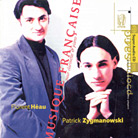 There is not exactly an abundance of music for clarinet and
piano, so it is good to have this disc come along. Not only does it contain compositions
for this particular duo, it also presents darn good music. The Chausson and Saint-Saëns
are real finds. They are both succinct, lyrical pieces that are so well written that they
sound as if they could only be played by this particular combination of instruments. The
pithy Poulenc has been recorded a few times but never better than this. The two
exceptionally talented young artists have an uncanny affinity for the music, and for each
other’s playing. They often seem to play like one extended musician. The recorded
sound is intimate and very realistic. When I close my eyes, my ears tell the truth; it
seems as if there was actually a clarinetist and piano in the room. What more could one
want? There is not exactly an abundance of music for clarinet and
piano, so it is good to have this disc come along. Not only does it contain compositions
for this particular duo, it also presents darn good music. The Chausson and Saint-Saëns
are real finds. They are both succinct, lyrical pieces that are so well written that they
sound as if they could only be played by this particular combination of instruments. The
pithy Poulenc has been recorded a few times but never better than this. The two
exceptionally talented young artists have an uncanny affinity for the music, and for each
other’s playing. They often seem to play like one extended musician. The recorded
sound is intimate and very realistic. When I close my eyes, my ears tell the truth; it
seems as if there was actually a clarinetist and piano in the room. What more could one
want?
|
Prokofiev: Alexander Nevsky*/Mussorgsky
(Orchestrated by Ravel): Pictures at an Exhibition.
*Lili Chookasian, contralto; *The Westminster Choir; New York Philharmonic; Thomas
Schippers, conductor.
Sony SS 87711, SACD. Contains advanced-resolution 5.0 and 2.0 mixes.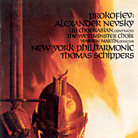 Here are two showpieces just right to take advantage
of advanced-resolution sound. The performances are from the 1960s and are both dynamic and
full of high energy. I think the Nevsky is one of the very best in the catalog,
with Schippers providing exciting leadership. Both orchestra and chorus are at their best,
and soloist Lili Chookasian makes "The Field of the Dead" a heart-rending
experience. The reading of Pictures is colorful and direct. Schippers seems to
strive for color while sacrificing lyricism, but this is literally built into the piece,
so all the elements balance out satisfactorily. The original recording was a marvel for
its day and SACD producer Louise de la Fuente has transferred it to SACD with loving care.
She explains to me that although the master for Nevsky was three track, everything
needs to be re-mixed when going to a new format, including both stereo and multichannel
versions. This has been done with great expertise. The front soundstage is firmly
anchored. I seem to remember that the original stereo LP had a chart that showed where all
the performers were. The sound here is so stable that one can tell location without any
accompanying picture. Chookasian’s voice is almost entirely in the center channel,
which sets her just a few feet in front of the orchestra at the conductor’s podium --
the right location. The surrounds are totally natural. All you will hear there is very
discreet and appropriate reverberation. I could give the whole column over to details, but
I have to sum it up by saying that this is among the best multichannel recordings I have
heard. The only fault to find with it is that it is not a hybrid disc; buyers must have an
SACD player to experience it. Too bad, when there is so much to enjoy. Here are two showpieces just right to take advantage
of advanced-resolution sound. The performances are from the 1960s and are both dynamic and
full of high energy. I think the Nevsky is one of the very best in the catalog,
with Schippers providing exciting leadership. Both orchestra and chorus are at their best,
and soloist Lili Chookasian makes "The Field of the Dead" a heart-rending
experience. The reading of Pictures is colorful and direct. Schippers seems to
strive for color while sacrificing lyricism, but this is literally built into the piece,
so all the elements balance out satisfactorily. The original recording was a marvel for
its day and SACD producer Louise de la Fuente has transferred it to SACD with loving care.
She explains to me that although the master for Nevsky was three track, everything
needs to be re-mixed when going to a new format, including both stereo and multichannel
versions. This has been done with great expertise. The front soundstage is firmly
anchored. I seem to remember that the original stereo LP had a chart that showed where all
the performers were. The sound here is so stable that one can tell location without any
accompanying picture. Chookasian’s voice is almost entirely in the center channel,
which sets her just a few feet in front of the orchestra at the conductor’s podium --
the right location. The surrounds are totally natural. All you will hear there is very
discreet and appropriate reverberation. I could give the whole column over to details, but
I have to sum it up by saying that this is among the best multichannel recordings I have
heard. The only fault to find with it is that it is not a hybrid disc; buyers must have an
SACD player to experience it. Too bad, when there is so much to enjoy.
|
...Rad Bennett
radb@ultraaudio.com

All contents copyright Schneider Publishing Inc., all rights
reserved.
Any reproduction, without permission, is prohibited.
Ultra Audio is part of the SoundStage! Network.
A world of websites and publications for audio, video, music, and movie enthusiasts. |

 Radical Sounds:
Keeping Secrets from a Public that Wants to Know?
Radical Sounds:
Keeping Secrets from a Public that Wants to Know?

 Here is another triumph from Mark Waldrep and his fledgling AIX label. For
this hybrid DVD, he has assembled three great musicians, players who obviously enjoy
working together and have a special affinity for the Latin repertory. He has deployed them
logically on a stage in a small auditorium: piano on the left, percussion on the right,
bass in the middle. Then, using his 24/96 recording wizardry, he has captured them in
sound that has just the right amount of everything: presence, clarity, and warmth. As
usual, he has provided a double-sided hybrid disc. One side is DVD-Video and contains
full-motion video, with a Dolby Digital "stage" perspective mix. For the other
side, which is MLP 24/96 DVD-Audio, he has selected an "audience" mix that puts
just a little distance between players and listener. Not too much, mind you. It seems just
right to me. The listener is not a participant in this mix, yet thanks to a very discreet
bit of ambiance in the surrounds, there is a feeling of intimacy and being in the same
space as the musicians. Most listeners will immediately note the clarity of this MLP 5.1
mix, especially in reproducing tingly percussion such as wind chimes, bells, and struck
cymbal. If you are one of those who are absolutely against any trace of surround, Waldrep
has also provided clean-as-a-whistle 24/96 stereo tracks. The video side of this hybrid
disc contains a lot of information on the recording process and the performers, as well as
a photo gallery and system setup and check information. Overall, this is an outstanding
release that sizzles, but in a gentle way.
Here is another triumph from Mark Waldrep and his fledgling AIX label. For
this hybrid DVD, he has assembled three great musicians, players who obviously enjoy
working together and have a special affinity for the Latin repertory. He has deployed them
logically on a stage in a small auditorium: piano on the left, percussion on the right,
bass in the middle. Then, using his 24/96 recording wizardry, he has captured them in
sound that has just the right amount of everything: presence, clarity, and warmth. As
usual, he has provided a double-sided hybrid disc. One side is DVD-Video and contains
full-motion video, with a Dolby Digital "stage" perspective mix. For the other
side, which is MLP 24/96 DVD-Audio, he has selected an "audience" mix that puts
just a little distance between players and listener. Not too much, mind you. It seems just
right to me. The listener is not a participant in this mix, yet thanks to a very discreet
bit of ambiance in the surrounds, there is a feeling of intimacy and being in the same
space as the musicians. Most listeners will immediately note the clarity of this MLP 5.1
mix, especially in reproducing tingly percussion such as wind chimes, bells, and struck
cymbal. If you are one of those who are absolutely against any trace of surround, Waldrep
has also provided clean-as-a-whistle 24/96 stereo tracks. The video side of this hybrid
disc contains a lot of information on the recording process and the performers, as well as
a photo gallery and system setup and check information. Overall, this is an outstanding
release that sizzles, but in a gentle way. There is not exactly an abundance of music for clarinet and
piano, so it is good to have this disc come along. Not only does it contain compositions
for this particular duo, it also presents darn good music. The Chausson and Saint-Saëns
are real finds. They are both succinct, lyrical pieces that are so well written that they
sound as if they could only be played by this particular combination of instruments. The
pithy Poulenc has been recorded a few times but never better than this. The two
exceptionally talented young artists have an uncanny affinity for the music, and for each
other’s playing. They often seem to play like one extended musician. The recorded
sound is intimate and very realistic. When I close my eyes, my ears tell the truth; it
seems as if there was actually a clarinetist and piano in the room. What more could one
want?
There is not exactly an abundance of music for clarinet and
piano, so it is good to have this disc come along. Not only does it contain compositions
for this particular duo, it also presents darn good music. The Chausson and Saint-Saëns
are real finds. They are both succinct, lyrical pieces that are so well written that they
sound as if they could only be played by this particular combination of instruments. The
pithy Poulenc has been recorded a few times but never better than this. The two
exceptionally talented young artists have an uncanny affinity for the music, and for each
other’s playing. They often seem to play like one extended musician. The recorded
sound is intimate and very realistic. When I close my eyes, my ears tell the truth; it
seems as if there was actually a clarinetist and piano in the room. What more could one
want?  Here are two showpieces just right to take advantage
of advanced-resolution sound. The performances are from the 1960s and are both dynamic and
full of high energy. I think the Nevsky is one of the very best in the catalog,
with Schippers providing exciting leadership. Both orchestra and chorus are at their best,
and soloist Lili Chookasian makes "The Field of the Dead" a heart-rending
experience. The reading of Pictures is colorful and direct. Schippers seems to
strive for color while sacrificing lyricism, but this is literally built into the piece,
so all the elements balance out satisfactorily. The original recording was a marvel for
its day and SACD producer Louise de la Fuente has transferred it to SACD with loving care.
She explains to me that although the master for Nevsky was three track, everything
needs to be re-mixed when going to a new format, including both stereo and multichannel
versions. This has been done with great expertise. The front soundstage is firmly
anchored. I seem to remember that the original stereo LP had a chart that showed where all
the performers were. The sound here is so stable that one can tell location without any
accompanying picture. Chookasian’s voice is almost entirely in the center channel,
which sets her just a few feet in front of the orchestra at the conductor’s podium --
the right location. The surrounds are totally natural. All you will hear there is very
discreet and appropriate reverberation. I could give the whole column over to details, but
I have to sum it up by saying that this is among the best multichannel recordings I have
heard. The only fault to find with it is that it is not a hybrid disc; buyers must have an
SACD player to experience it. Too bad, when there is so much to enjoy.
Here are two showpieces just right to take advantage
of advanced-resolution sound. The performances are from the 1960s and are both dynamic and
full of high energy. I think the Nevsky is one of the very best in the catalog,
with Schippers providing exciting leadership. Both orchestra and chorus are at their best,
and soloist Lili Chookasian makes "The Field of the Dead" a heart-rending
experience. The reading of Pictures is colorful and direct. Schippers seems to
strive for color while sacrificing lyricism, but this is literally built into the piece,
so all the elements balance out satisfactorily. The original recording was a marvel for
its day and SACD producer Louise de la Fuente has transferred it to SACD with loving care.
She explains to me that although the master for Nevsky was three track, everything
needs to be re-mixed when going to a new format, including both stereo and multichannel
versions. This has been done with great expertise. The front soundstage is firmly
anchored. I seem to remember that the original stereo LP had a chart that showed where all
the performers were. The sound here is so stable that one can tell location without any
accompanying picture. Chookasian’s voice is almost entirely in the center channel,
which sets her just a few feet in front of the orchestra at the conductor’s podium --
the right location. The surrounds are totally natural. All you will hear there is very
discreet and appropriate reverberation. I could give the whole column over to details, but
I have to sum it up by saying that this is among the best multichannel recordings I have
heard. The only fault to find with it is that it is not a hybrid disc; buyers must have an
SACD player to experience it. Too bad, when there is so much to enjoy.